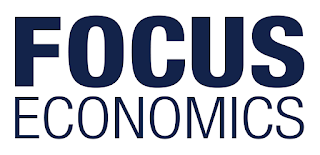The economy will contract sharply this year. Anemic household confidence and sky-high unemployment will suppress consumer spending, while investment and trade are set to decline. Fiscal and monetary stimulus should help cushion the blow, however. A possible second wave of infections, tensions with China and recent social unrest are key risks. FocusEconomics panelists see GDP contracting 5.8% in 2020, which is down 0.4 percentage points from last month’s forecast, before growing 4.8% in 2021.
The economy shrank at the sharpest rate since Q4 2008 in the first quarter as the pandemic and measures to contain it hammered activity. According to a second GDP estimate released by the Bureau of Economic Analysis, the economy contracted 5.0% in Q1 in seasonally-adjusted annualized terms (SAAR), even sharper than the first estimate of a 4.8% fall. In annual terms, GDP grew 0.3% in Q1, decelerating markedly from Q4’s 2.3% growth and matching the first estimate.
The economy shrank at the sharpest rate since Q4 2008 in the first quarter as the pandemic and measures to contain it hammered activity. According to a second GDP estimate released by the Bureau of Economic Analysis, the economy contracted 5.0% in Q1 in seasonally-adjusted annualized terms (SAAR), even sharper than the first estimate of a 4.8% fall. In annual terms, GDP grew 0.3% in Q1, decelerating markedly from Q4’s 2.3% growth and matching the first estimate. The largest drag on the economy in Q1 came from private consumption, which plunged 6.8% SAAR (Q4: +1.8% SAAR).
Moreover, the downturn in business investment, which has been underway since the second half of last year, intensified significantly (Q1: -7.9% SAAR; Q4: -2.4% SAAR) on a marked drop in equipment investment. Meanwhile, public outlays moderated in the quarter (Q1: +0.8% SAAR; Q4: +2.5% SAAR) on weaker defence spending and state and local expenditure. Turning to the external sector, exports of goods and services contracted 8.7% in the first quarter (Q4: +2.1% SAAR), led by a freefall in exports of services, while goods exports fell at a softer rate. Imports of goods and services shrank 15.5%, leading the external sector to contribute 1.3 percentage points to the headline figure (Q4: +1.5 percentage points). The first quarter’s contraction is likely just the tip of the iceberg in terms of the economic impact of the pandemic. While unprecedented fiscal and monetary stimulus should soften the blow, FocusEconomics panelists project the economy to contract in Q2 at the sharpest rate since the Great Depression.
Extensive damage to the labor market—with over 40 million Americans recently having filed for unemployment benefits—will be hitting private consumption hard. Moreover, lockdowns abroad will be weighing on exports. James Knightley, chief international economist at ING, is downbeat about prospects: “We doubt that the US will experience a V-shaped recovery. The social distancing constraints, likely ongoing consumer caution until there is a vaccine plus the impact on aggregate demand from mass unemployment will limit the pace of the rebound.
Throw in the potential for long-term structural changes (think business travel and home working as examples) and it means at best we think the lost output in 1Q and 2Q won’t be fully regained until late 2022 at the very earliest.” FocusEconomics Consensus Forecast panelists expect GDP to contract 5.8% in 2020, which is down 0.4 percentage points from last month’s estimate. For 2021, the panel expects the economy to expand 4.8%.



